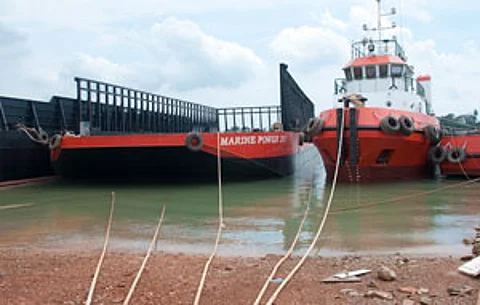

As with many businesses in Southeast Asia, the Bahtera Bahari Shipyard on Indonesia's Batam Island is a family business. Although the present company was founded only recently, in 2005, the family's association with the marine world of Indonesia extends back several decades.
One of four children, Ms. Tresya, the oldest of two sisters, completed her training in project management in Australia. She is now a director of the company and involved in marketing and bringing modern management models to the shipyard as well as an extensive network of inter-related companies. She recently gave a very brief account of the company's history.
Her father, Hengky Suryawan, was born in 1949 and began a small shipping agency company and then ventured into ferry services on Bintan Island in the 80s. As this expanded he learned that transporting inanimate cargos such as sand, logs and coal was a more profitable and much more straight forward. The logistics of arranging cargos let to the development of a shipping company of tugs and barges. This, in turn, led to the acquisition of a quarry and then coal and iron ore mining properties. What began as a company repair yard has morphed into a full shipyard doing new construction of landing craft, tugs and barges.
Now as the four children come of age they are moving into the management of the group of companies. Having grown up around boats and shipyards they are able to apply their overseas educations in a pragmatic fashion that is leading to a stronger fusion of traditional and modern technologies and management. Both Ms. Tresya's brothers, Selamat Budiman and Selamet Widodo are directors of the shipbuilding yard and the shipping arm while a brother-in-law, Mr. Rudiyanto, is the President Director of the shipyard.
On a recent visit to the yard on Batam Island, Ms. Tresya showed visitors around the yard and toured a recently launched tug, one of three 29- by eight-metre boats moored to a cluster of new barges. The 'Marina 30' belongs to the family's extensive fleet of tugs, all of which are named 'Marina' or 'Dabo'.
This class of vessel is a good-sized 29- by eight-metre tug with a 3.7-metre moulded depth. The functional and roomy wheelhouse has dual sets of engine controls, one each of the port and starboard main engines. The uncluttered control panel included remote stars for the generator sets, a rudder indicator, compass, VHF and SSB radios, a radar, a GPS and echo sounder.
Two decks down, the functionality is repeated in the engine room. The two big Cummins KTA38-M2 diesels, each generating 900kW at 1,800RPM, turn into Masson Marine W5200 gears with 5.955:1 reductions. Electrical services are met with a single Cummins 4BT3.9-GI powered 50 kW generator.
The air-conditioned accommodation area includes a comfortable lounge/mess area with a separate compact galley on the port side. On the tug's bow an electric-powered anchor winch provides a maximum torque of two tonnes. On the after deck a 40-tonne towing hook is mounted just aft of the main cabin.
The 'Marina 30' has joined the company fleet providing charter services but also moving coal, iron ore and aggregate from the family's other operations.
